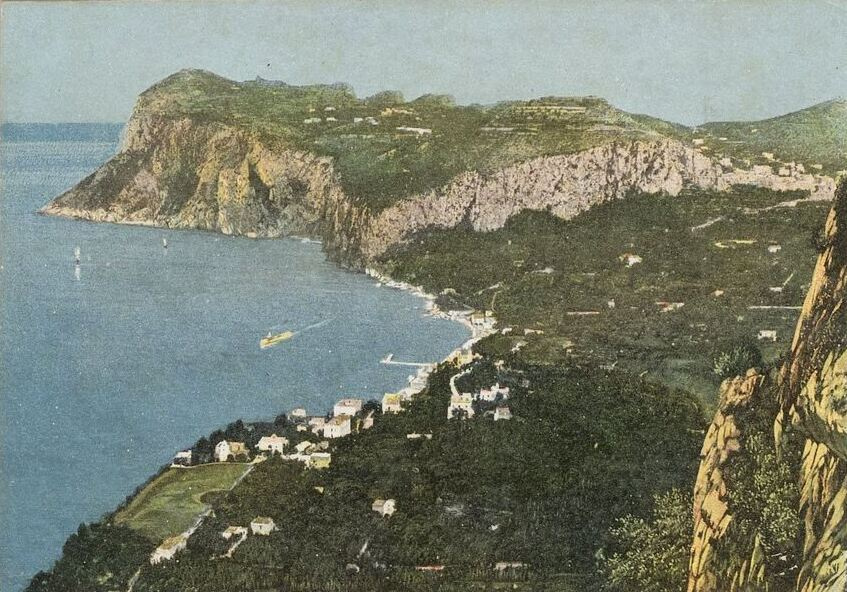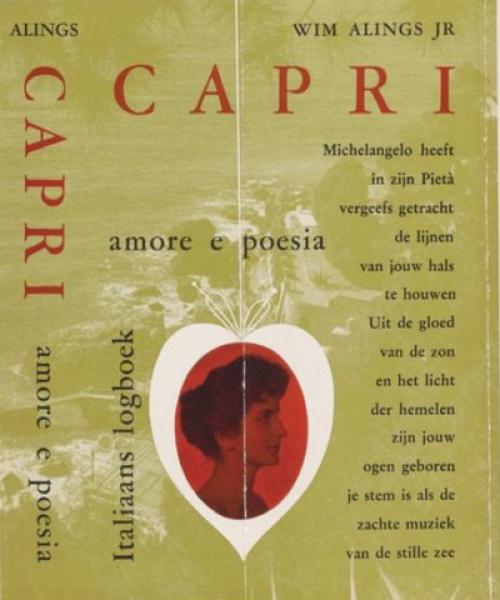In an earlier blog, I wrote about Wim Alings’ experience in Naples as described in his 1958 book Napels, stad vol gevallen engelen (Naples, city of fallen angels). That book ends with Alings’ decision to leave Naples because, according to him, he never really felt part of life in the city and felt no more than a stranger there. (Alings Jr. 1958: 149-150) Those who do not know better might think that this decision marked Alings’ experience in Italy. However, nothing could be further from the truth.
Besides the book Napels, stad vol gevallen engelen, the author wrote several other travel reports and guides about Italy between 1957 and 1967. His books Capri, Amore e Poesia and Hier is Rome (Here is Rome) are digitally accessible. In Capri, Amore e Poesia the author takes us along on one of his trips to Italy. Just as in Napels, stad vol gevallen engelen he does this on the basis of twenty anecdotes. His decision to leave for Italy arises one afternoon in a room in a city whose name we are not told. He writes:
I know this is not life. I can clearly see the advertisements in the newspaper that has fallen beside my chair: 'In Rome it is now Spring! These words aggravate the feeling I've had for weeks now. No illness, no pain either. Just a mildly poignant, not even obtrusive, feeling that never goes away. […] It is a desire to escape to where spring is now. To countries with which the travel agencies advertise. To Menton or Naples, to Syracuse or Palermo. An escape from the thick grey of this city to where the flowering broom hangs like yellow garlands from the mountains. The city I love no longer exists. (Alings jr. 1957: 14)
Driven by the desire to escape the eternal grey skies and rain, Alings travels from Florence to Southern Italy because ‘the South alone promised the sought-after sun’. (Alings jr. 1957: 19) He first ends up in Rome, which he calls Southern Italy, and where he will spend several weeks. In response to an article by the writer Malaparte in Il tempo, Alings decides to move further south, along the Via Appia Antica, past Terracina – the ‘gateway to the real south’, according to the writer. (Alings jr. 1957: 23)
His journey takes him to Naples, about which he mainly speaks out in this book against the generally accepted assumption that only thieves live in Naples, a theme that will return in his later book Napels, stad vol gevallen engelen. He writes: ‘No, the tourist will not find those real crooks. If you ever talk to a fellow countryman whose wallet or purse has been stolen, tell him that the same thing happened to me. On tram line sixteen in Amsterdam.’ (Alings jr. 1957: 39)
From Naples, Alings visited Pompeii, Amalfi and Paestum, and then continued southwards through Lucania and Calabria, two regions whose poverty and superstitious traditions particularly impressed him. He wrote about the superstitions in the provinces:
The greatest calamity there is still the breaking of a bottle of oil, which can only be remedied by immediately breaking a bottle of wine in the same place. It is also unfortunate to fold a napkin while still seated at the table. Misfortune is approached by leaving a pair of scissors open, mentioning the number seventeen, unfolding an umbrella indoors, stepping over a threshold with one's left foot and passing a hooded monk. (Alings jr. 1957: 60-61)
Alings then crossed over to Sicily by boat. He describes the island as follows: ‘Sicily is a fairy-tale island, art and nature are inseparably united there, the most beautiful monuments stand in the most beautiful landscape imaginable.’ (Alings jr. 1957: 65) The descriptions of the island are brief, only Agrigento is mentioned shortly. When Alings receives word from his Neapolitan friend Gigi about a well-paying job on Capri, he decides to leave immediately. He rents a room in the village of Ana Capri and is hired as a bartender in the bar where Gigi also works. In the evenings the men work, the days they spend on the beach, dreaming of the future.

Because the polizia finds out that Alings has no work permit, he is fired after a few weeks. Despite his dismissal, Alings remains on Capri and during the feast of Saint San Antonio he meets Linuccia, with whom he has a passionate relationship. Whereas Alings first writes about his stay on Capri in a somewhat melancholy tone, particularly with regard to the lack of prospects, the travelogue later takes on a completely different tone: after his meeting with Linuccia, the author finds himself in an ecstasy of love and we suddenly see life on Capri through these rose-coloured glasses as well. He writes:
The rhythm of life here has the cadence of cat's paws; the full days of summer slip by unnoticed, autumn is incomprehensibly distant, spring still lasts until the end of October. It is this certainty that makes you feel how sweet life is. The job in the motherland is forgotten, the regular and regulated work, the house with the electric heater and the floor lamp. Oh, blissful idleness, day in day out, even the unanswered correspondence does not bother me. There are so many more delightful things than tedious assignments that spoil the lives of idlers. (Alings jr. 1957: 132)
The ecstasy, however, turns out to be short-lived. Linuccia decides it is better to break off the relationship, after which the deeply saddened Alings returns to the Netherlands. Alings waits in vain for letters from Linuccia. Only months later he receives a letter from Linuccia asking: ‘If you love me half as much as you say you do, then you can do only one thing for me, never let me hear from you again.’ (Alings jr. 1957: 139) Alings decides to return to Capri, hoping to change Linuccia’s mind. A series of upheavals ensue in which Alings stays in Rome as well as on Capri, writing his travel guide Hier is Rome. Eventually Linuccia gives in and they restart their relationship. Together they experience the autumn and winter months on the island, which, because of the many parties and merciful people, cannot be compared to the bleak life in the Netherlands that Alings described at the beginning of his book.
In Capri, Amore e Poesia, Alings takes you along in his search for sunshine, for a life outside the bleak Netherlands, and the author seems to have found this on Capri: in the dedication to Linuccia preceding the book, he writes in Italian: ‘Mi hai dato un'altra patria, una vita sotto un più largo orizzonte.’ In other words: You have given me another homeland, another life under a wider horizon.
Bibliography
Alings jr., Wim, Capri, Amore e Poesia, Baarn 1957.
Alings jr., Wim, Napels, stad vol gevallen engelen, Baarn 1958.
